


Following the early path envisioned by L. Esaki and R. Tsu [1], artificially tailored semiconducting heterostructures at the nanoscale now form the leading edge of device technology. Indeed, the design of modern electronic and optoelectronic devices heavily exploits the principles of the so-called "band-gap engineering" [2], achieved by confining charge carriers in spatial regions comparable to their de Broglie wavelengths.
The resulting wide family of quantum devices may be divided into two main classes: a first one comprising semiconductor systems characterized by a genuine quantum-mechanical carrier behavior, and a second one made up of low-dimensional nanostructures whose transport dynamics may be safely treated within the Boltzmann-transport picture.The impressive range of novel designs and architectures that the control and understanding
of quantum phenomena allow for, together with the continued size-scaling in electronics, are the main motivations for the various microscopic simulation tools developed by our group [3,4]. Few of the most relevant applications addressed in the last years are listed below.
[1] L. Esaki and R. Tsu, "Superlattice and negative differential conductivity in semiconductors", IBM J. Res. Dev. 14, 61 (1970).
[2] F. Capasso, Bandgap Engineering: the Physics of Heterostructure Semiconductor Devices (John Wiley & Sons, Chichester, 2009).
[3] R.C. Iotti and F. Rossi, Microscopic theory of semiconductor-based optoelectronic devices, Reports on Progress in Physics 68, 2533 (2005).
[4] F. Rossi, Theory of Semiconductor Quantum Devices (Springer, Berlin Heidelberg, 2011).

➤ Design and Optimization of Quantum Cascade Lasers
Quantum-cascade lasers are an excellent example of how the principles of band-gap engineering can be used to design new materials and related light sources.
The operation of these devices requires a careful design of the core region: energy levels, optical matrix elements, scattering rates and relaxation times have to be properly tailored in order to maintain a gain regime at the desired emission frequency. Due to the many variables involved, reliable and predictive device modelling and optimization demand deep understanding and control of the most relevant physical processes.
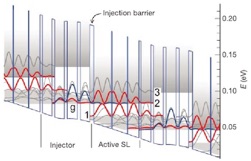

➤ Novel THz detection schemes
The development of reliable far-infrared (far-IR) semiconductor-based laser sources, such as the quantum cascade laser, together with their potential applications in imaging, communication, and medicine, identifies terahertz radiation detection as a crucial technological milestone.
To this end, we investigated the feasibility of extending the conventional bound-to-continuum principle, successfully employed for mid-IR quantum-well-based photodetectors, into a bound-to-bound-to-continuum architecture suitable for terahertz operation. Indeed, in the far-IR region, the performances of single-bound-subband devices, are severely hindered by high dark current and low T_blip values. We demonstrated that, in this respect, the multi-subband scheme represents a promising approach.

References
J. Faist, F. Capasso, D.L. Sivco, C. Sirtori, and A.Y. Cho, Quantum Cascade Lasers, Science 264, 553 (1994).
R.C. Iotti and F. Rossi, Nature of Charge Transport in Quantum-Cascade Lasers, Phys. Rev. Lett. 87, 146603 (2001).
R. Köhler, R.C. Iotti, A. Tredicucci, and F. Rossi, Design and simulation of THz quantum-cascade lasers, Appl. Phys. Lett. 79, 3920 (2001).
R. Köhler, A. Tredicucci, F. Beltram, H. E. Beere, E.H. Linfield, A. Giles Davies, D. A. Ritchie, R. C. Iotti, and F. Rossi, Terahertz semiconductor-heterostructure laser, Nature 417, 156 (2002).
R.C. Iotti, S. Savasta, and F. Rossi, Electron-photon coupling in opto-electronic quantum devices: from electroluminescence to lasing, 28th International Conference on the Physics of Semiconductors (ICPS-28), Vienna (AT), AIP Conference Proceedings vol. 893, p. 1449, edited by W. Jantsch and F. Schaeffer (New York, 2007).
R.C. Iotti, F. Rossi, M.S. Vitiello, G. Scamarcio, L. Mahler, and A. Tredicucci, Impact of non-equilibrium phonons on the electron dynamics in terahertz quantum cascade lasers, Appl. Phys. Lett. 97, 033110 (2010).
S. Vitiello M.S., Iotti R.C., Rossi F., Mahler L., Tredicucci A., Beere H.E., Ritchie D.A., Hu Q., Scamarcio G., Non equilibrium longitudinal and transverse optical phonons in terahertz quantum cascade lasers, Appl. Phys. Lett. 100, 091101 (2012)
References
F. Castellano, R. C. Iotti, and F. Rossi, Terahertz detection schemes based on sequential multiphoton absorption, Appl. Phys. Lett. 88, 182111 (2006).
F. Castellano, R. C. Iotti, and F. Rossi, Sequential multiphoton strategy for semiconductor-based terahertz detectors, J. Appl. Phys. 104, 123104 (2008).
F. Castellano, R. C. Iotti, F. Rossi, J. Faist. E. Lhuillier, and V. Berger, Modeling of dark current in mid-infrared quantum-well infrared photodetectors, Infrared Physics and Technology 52, 220 (2009).
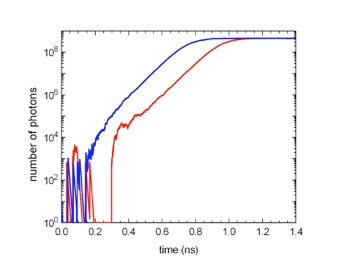
In this respect, our focus is on the development of diverse theoretical models and computational tools that help to correlate, at a microscopic level, basic physics and fundamental phenomena to device performances. Among the most significant achievements, we may mention the realization of the first terahertz heterostructure laser, in collaboration with A. Tredicucci and co-workers at NEST-Scuola Normale Superiore in Pisa, and E. Linfield and co-workers at Cavendish Laboratory in Cambridge.

➤ Ultrafast carrier dynamics in photoexcited semiconductors
In the presence of ultrafast electro-optical excitations of a semiconductor crystal as well as of ultrafast measurements (i.e., comparable to the so-called collision duration), the assumption of instantaneous and completed collisions (as described via the popular Fermi's golden rule) is definitely inadequate; indeed, via many time-resolved experiments it is possible to detect energy-nonconserving transitions (see Fig. on the left) both in carrier-photon and carrier-phonon interaction processes.
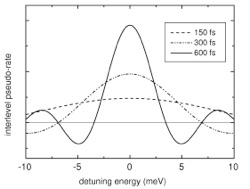
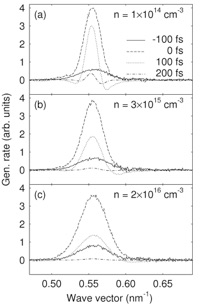
In particular, thanks to the generalized Monte Carlo simulation strategy proposed in 1992 by F. Rossi and T. Kuhn (see Chap. 5 in [1]) it has been possible to shine light on the non-trivial interplay between coherent and incoherent phenomena in the electron-hole photogeneration process (see Fig. on the right).
➤ High-field Quantum transport
In the presence of strong applied fields, the usual description of carrier-phonon scattering processes between field-free electronic states is highly questionable. In other words, in the high-field regime it is not possible to neglect the effect of the field during the collision process, the so-called Intracollisional field effect (ICFE). The fully microscopic investigation of electron transport in semiconductor superlattices presented in [3] has provided a definite question to this long-standing controversy, showing that a gauge-invariant treatment of the problem leads to a significant underestimation of the ICFE (see Fig. on the right).
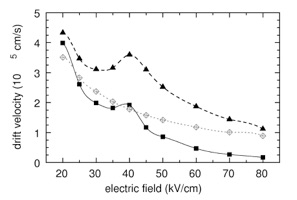
➤ Microscopic Theory of energy Dissipation and Decoherence
Aim of this research activity is to revisit the conventional adiabatic or Markov approximation, which - contrary to the semiclassical case - does not preserve the positive-definite character of the corresponding density matrix, thus leading to highly non-physical results. To overcome this serious limitation, originally pointed out by Davies and co-workers almost three decades ago, we have recently proposed an alternative adiabatic procedure [4], which (i) in the semiclassical limit reduces to the standard Fermi's golden rule, and (ii) describes a genuine Lindblad evolution, thus providing a reliable/robust treatment of energy-dissipation and decoherence processes in electronic quantum devices.
References
F. Rossi, Theory of Semiconductor Quantum Devices (Springer, Berlin Heidelberg, 2011).
F. Rossi and T. Kuhn, Theory of Ultrafast Phenomena in Photoexcited Semiconductors, Rev. Mod. Phys. 74, 895 (2002).
D. Taj, R.C. Iotti, and F. Rossi, Microscopic modeling of energy relaxation and decoherence in quantum optoelectronic devices at the nanoscale, Eur. Phys. J. B 72, 305 (2009).
E. Ciancio, R. C. Iotti, and F. Rossi, Gauge-invariant formulation of Fermi's Golden Rule: Application to high-field transport in semiconductors, Europhys. Lett. 65, 242 (2004).
Nanophysics and Quantum Systems
